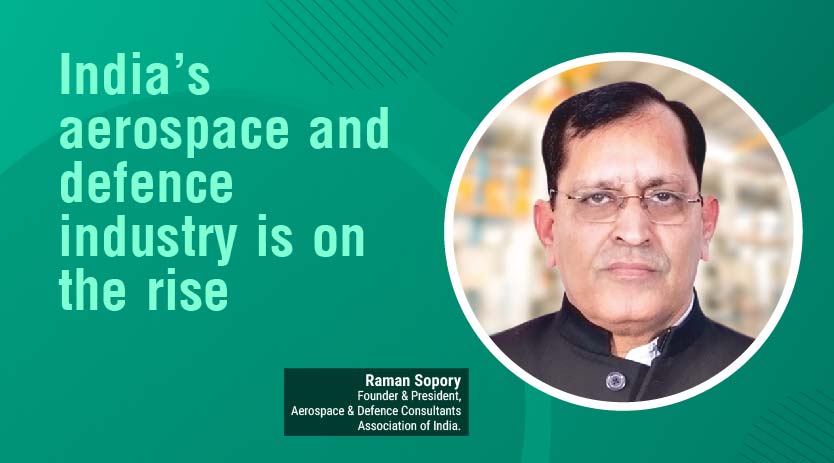India’s Turn Toward Defence ‘Self-Reliance’
August 1, 2020 11:53 am
The comprehensive reform package for the defence sector should enable India to capitalise on the investments made and capabilities created in Indian industry under the “Make in India” initiative during the last five years.
Sujith Haridas, Director General, Society of Indian Defence Manufacturers (SIDM)
We are certain that as projects under “Strategic Partnership Model” roll out during the next 3-4 years, the private industries would also create capability and capacity in segments such as fighter aircraft, helicopters, submarines and armoured fighting vehicles including main battle tanks, said Sujith Haridas, Director General, Society of Indian Defence Manufacturers (SIDM) in an interview with Subhajit Roy. He also highlights the actions been taken at the policy level to foster innovation and technology that will push the manufacturing reforms. Excerpts:
The Indian government has expressed its commitment of making India ‘AtmaNirbhar’ in defence production. What will it take for India to reach its indigenisation goals?
Prime Minister’s clarion call for AtmaNirbhar Bharat and the roadmap for ‘AtmaNirbhar Bharat Abhiyan (self reliant India campaign)’ are to be built on five pillars: Economy, Infrastructure, Systems based on 21st century technology driven arrangements, Vibrant Demography, and Demand – which utilises the strength of demand and supply chain to full capacity.
This call of “AtmaNirbharta” is most relevant for defence and aerospace sector, which is highly dependent on imports at present. Given India’s high dependence on imports to the tune of 60-65 percent of annual capital budget, defence and aerospace sector presents a huge potential for double-digit growth of Indian industry – both public and private.
The Government of India has therefore set a calibrated, well-thought-out structural glide-path for development of Indian defence and aerospace sector, as announced by the Finance Minister on 16th May, towards making India “AtmaNirbhar” for its defence needs.
The comprehensive reform package for the defence sector should enable India to capitalise on the investments made and capabilities created in Indian industry under the “Make in India” initiative during the last five years.
The policy reforms related to progressive ban on import of identified weapons/platforms, as the Indian industry builds capability and capacity to meet the capability requirements of the Services, will create potentially very large investment avenues, infusion of technology into the sector, and generate lakhs of high skill jobs for our technically qualified manpower.
Defence Procurement Procedure (DPP), a draft of which was circulated in March 2020, will incorporate the thematic requirements of time-bound defence procurement process and faster decision making – both in process design (GSQRs formulation, trial procedures) or process management. As per new policy proposal, the government will allocate separate capital budget for Indian industry.
All these are path-breaking, structural reforms. In the next 5 years, these have the potential to change the Indian defence and aerospace industry landscape and make us “self-reliant” in critical defence platforms and weapon systems.
What are the major bottlenecks in creating an efficient eco-system for defence production?
The defence sector is monopsonic with a single buyer (MoD) and is characterised by high technology, low volume requirements. The demand for individual equipment also tends to be lumpy. These do pose challenges of not only scale of operations but also investment in cutting-edge technologies.
The above characteristic features of doing business in defence sector, when viewed with the long-drawn, protracted procurement processes of DPP can be back-breaking even for large business houses. One does believe that these aspects are equally well reckoned by the government while announcing the reform package announced on 16th May.
Brief us on the preparedness of Indian defence manufacturing sector in terms of indigenisation?
For almost six decades, the Indian defence forces relied either on imports or the government-owned production facilities such as Ordnance Factories (OFs) and Public Sector Undertakings (PSUs) to meet their capability requirements.
The private sector industries have participated in defence production as tiered partners to OFs and DPSUs for over four decades. However, since opening of the sector in 2002, the private sector industries including MSMEs have created a very significant footprint in the defence industry ecosystem. So, from being tiered partners, private industries are now in a position to compete with the DPSUs/OFs in almost every major segment. Consider this, till a few years ago, HAL manufactured every major airframe component in-house. But look at the LCA program today – all major parts of the LCA airframe are being manufactured by the partners in private industry. Similarly, in other areas too industries have invested in technologies, manufacturing infrastructure and skills to build a very strong eco-system. There are over 8,000 industries which make that eco-system.
We are certain that as projects under “Strategic Partnership Model” roll out during the next 3-4 years, the private industries would also create capability and capacity in segments such as fighter aircraft, helicopters, submarines and armoured fighting vehicles including main battle tanks.
The production of the K-9 Vajra with more than 80 percent indigenous content and towed artillery guns by four of our industry members, are testimony of indigenous manufacturing capability of the Indian industry.
The Indian defence industries have also integrated well into the supply chains of FOEMs as also in some cases, supplying platforms to countries in South Asian, African and South American countries.
Do you think enough action has been taken at the policy level to foster innovation and technology that will push the manufacturing reforms?
Yes, government has implemented several schemes to spur and harness innovation in technologies as well as products. NITI Aayog’s Atal Innovation Mission (AIM), Technology Development Fund and Innovation for Defence Excellence schemes of the MoD, are some such initiatives that are now well subscribed with the industry showing tremendous interest in these schemes. At the policy level, both central and state government have set up mechanisms to support innovations through dedicated funds as also institutionalising innovation hubs and incubation centres co-located with most major academic institutions. Start-up mission is another initiative that has helped many promising entrepreneurs to set up viable units supplying hi-tech items to the defence forces.
Apart from this, specifically for the defence sector, the three Services have created Directorates for Innovation and Indigenisation, which are responsible for promoting indigenisation and import substitution projects.
In my opinion, introduction of simplified Make-II procedure in DPP for participation of Indian private industries to develop indigenous solutions for the Indian Forces has been a very effective mechanism to harness the potential of the industry. Apart from taking up sponsored projects, the industries can also put suo moto proposals for their own technologies and products which may fulfil the capability needs of the Services. Then in 2019, extending of the Make-II procedure to OFs and DPSUs has opened up huge opportunities for the industries to showcase their capability for design and development of sub-systems/systems for applications in defence equipment and platforms. Over 3,200 projects for indigenisation and import substitution have been listed by the OFs and DPSUs.
These policy initiatives will certainly create broader base of capabilities as well as depth in the industry.
Now that the government has raised the FDI limit in the defence manufacturing from 49 percent to 74 percent under automatic route, how do you see the opportunities for domestic manufacturers?
Raising FDI in defence manufacturing under automatic route from 49 percent to 74 percent should enthuse several foreign OEMs to make investments in India, partner and collaborate with Indian industry to build capable supply nodes for their global demand. It is win-win for both foreign and Indian industries. One will however have to wait for the policy print to before making any conclusions. It may be recalled that even earlier GoI permitted 100 percent FDI in Defence on case-to-case basis in case modern technology was to be brought in.
Which are the allied industries that will drive this movement and get benefitted?
Defence is a sector of sectors, in the sense that it can’t be delinked from other industry sectors as the requirements of the Armed Forces are varied and all encompassing. The defence capabilities – be these in the form of platforms or individual systems – call for integration of diverse technologies in several domains. Therefore, in my opinion, as the Indian defence manufacturing expands, all industries connected with defence and aerospace sector will benefit equally.
Considering that major imports are in the area of military aviation platforms and system, investments would be needed to create indigenous capacity in several areas related to manufacturing, integration and testing of systems, including airframe structures, for aviation platforms – fighter aircrafts, helicopters and UAVs. Niche capabilities would also need to be created for working with special materials, including composite materials, for aerospace applications.
Towards achieving the goals of self-reliance in the strategic defence and aerospace sector, SIDM considers that the following should be the key agenda for implementation by the government:
Promulgate draft Defence Production Policy at the earliest, to reemphasis and bring into focus the stated intent to achieve self-reliance by 2025.
Encourage private sector participation in defence manufacturing: To encourage and attract private sector to make investment in defence manufacturing, there is a need to ensure volume, speed and continuity of orders. This will boost investment in infrastructure and R&D that is needed to build the required capacity indigenously. It will also encourage inflow of foreign technology and capital.
Time-bound implementation of SP Model: Introduction of SP Model in DPP 2016 is a path breaking reform. It can catalyse the private industry and introduce major structural change in the defence industry landscape. Having initiated the programs, it is necessary that a dedicated professional organisation operationalise SP model be created in MOD for rolling out projects in a time bound manner.
Create a new institutional mechanism for defence procurement: Procurement decision-making structures have evolved extensively since their creation in 2001, and promulgation of formal DPP in 2002. There is a need to reform the procurement organisation to bring in professional workforce, create focus, synergy as well accountability in building and sustaining military capability as well as industry capability and capacity. MoD should create suitable structures within the existing organisation to synergise all activities of R&D, production and procurement.
Industry has already submitted a very comprehensive set of suggestions and recommendations for review of DPP 2020. We are hopeful that DPP 2020 will be designed as an instrument to achieve the objective of creating dynamic, robust, competitive defence and aerospace industry in India, and lead to self-reliance in this strategic sector in a calibrated manner.
Cookie Consent
We use cookies to personalize your experience. By continuing to visit this website you agree to our Terms & Conditions, Privacy Policy and Cookie Policy.

















 English
English Hindi
Hindi